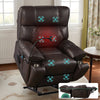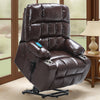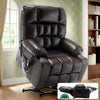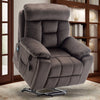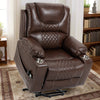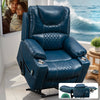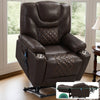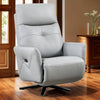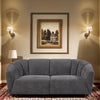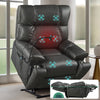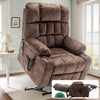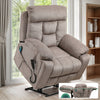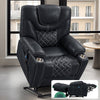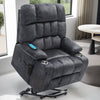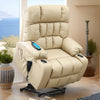Understanding the Power Lift Recliner: A Comprehensive Overview
What is a Power Lift Recliner?
A power lift recliner is a specialized chair designed to help seniors and those with mobility issues. It uses a motor to tilt forward and lift up, making it easier to stand or sit. These chairs also recline for comfort.

Power lift recliners come in various styles and sizes. They often have soft, durable upholstery and extra padding for comfort. Many models include features like heat and massage functions.
The main goal of a power lift recliner is to promote independence. It allows users to sit down and stand up without help from others. This can boost confidence and quality of life for many seniors.
The Evolution of Power Lift Recliners in the Senior Market
Power lift recliners have come a long way since their introduction. Early models were basic and focused only on the lifting function. Today's chairs offer much more.
In the past decade, manufacturers have added many new features. These include USB ports for charging devices and cup holders for convenience. Some chairs now have memory foam cushions for better support.
The senior market has driven much of this innovation. As the population ages, demand for these chairs has grown. This has led to more competition and better products for consumers.
Key Features of Top Power Lift Recliners
Top power lift recliners offer a range of features to enhance comfort and usability. Here are some key features to look for:
- Multiple position settings
- Quiet, smooth motors
- Easy-to-use remote controls
- Durable, stain-resistant fabrics
- Battery backup for power outages
- Heat and massage options
- Adjustable headrests and lumbar support
Some high-end models also include smart features. These might allow voice control or connection to home automation systems. The best chairs balance comfort, functionality, and ease of use.
The Benefits of Power Lift Recliners for Seniors
Enhancing Mobility and Independence
Power lift recliners play a crucial role in enhancing mobility for seniors. They make it easier to move from sitting to standing positions. This can be a game-changer for those with arthritis or back pain.

These chairs promote independence in daily activities. Users can get up without struggling or asking for help. This independence can boost self-esteem and mental well-being.
For many seniors, a power lift recliner means more than just comfort. It represents freedom and the ability to maintain their lifestyle. It allows them to continue enjoying their home without major changes.
Reducing the Risk of Falls and Injuries
Falls are a major concern for seniors. Power lift recliners can help reduce this risk in several ways. The gentle lifting motion prevents sudden movements that could cause loss of balance.
These chairs provide stable support during transitions. This is crucial for seniors with weak muscles or poor balance. The controlled movement helps users find their footing before standing fully.
By making it easier to sit and stand, these chairs also reduce strain on joints and muscles. This can help prevent injuries from overexertion. It's especially helpful for those with conditions like arthritis or osteoporosis.
How Power Lift Recliners Support Active Lifestyles
Power lift recliners can actually encourage more active lifestyles among seniors. By making it easier to get up, they remove a barrier to movement. This can lead to more frequent walks or engagement in hobbies.
These chairs also provide a comfortable place to rest between activities. This balance of support and comfort can help seniors maintain their energy throughout the day. It allows for periods of rest without becoming too sedentary.
Many seniors find that having a power lift recliner motivates them to stay active at home. They can easily transition from sitting to light exercises or stretching. This supports overall health and well-being.
Power Lift Recliners vs. Traditional Mobility Aids: A Closer Look
Comparing Power Lift Recliners with Wheelchairs
Power lift recliners and wheelchairs serve different needs, but both aid mobility. Wheelchairs are best for those who can't walk or stand for long periods. Lift recliners help with sitting and standing at home.

Wheelchairs offer more freedom of movement outside the home. They allow users to navigate various environments. Power lift recliners, on the other hand, provide comfort and support in a fixed location.
In terms of cost, power lift recliners are often more affordable than motorized wheelchairs. They also require less maintenance. However, wheelchairs may be covered by insurance more often than lift recliners.
The Advantages of Power Lift Recliners Over Walking Aids
Power lift recliners offer several advantages over traditional walking aids like canes or walkers. They provide more support and stability during the sit-to-stand motion. This can be safer for seniors with balance issues.
Unlike walking aids, power lift recliners don't require upper body strength to use. This makes them suitable for a wider range of users. They're especially helpful for those with arm or shoulder problems.
Lift recliners also serve as comfortable seating when not in use for mobility. Walking aids, while portable, don't offer the same level of comfort or relaxation. This dual function makes lift recliners more versatile.
Integrating Power Lift Recliners into Home and Care Settings
Power lift recliners can be easily integrated into most home settings. They come in various styles to match existing decor. This allows seniors to maintain their home's look while adding functional furniture.
In care settings, these chairs can reduce the workload for caregivers. They make transfers easier and safer. This can lead to better care and less physical strain on both caregivers and patients.
Many families find that adding a power lift recliner allows seniors to stay in their homes longer. It addresses mobility concerns without major home modifications. This can be a cost-effective way to support aging in place.








